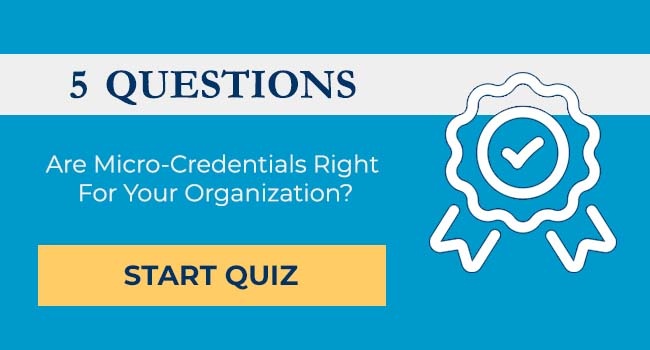
A Systematic Approach to Designing Effective Micro-Credentials
Consider the novel as it compares to the short story.
With a novel, the author has unlimited time and space to come to a satisfying conclusion.
Of course, many fail even at this.
The short story format, however, requires considerably more concision.
The writer has to include all the elements of a good story in just a few pages.
Needless to say, writing even a decent short story is much more difficult than writing a good novel.
Similarly, the traditional degree program compared to the micro-credential, has a heck of a lot more breathing room to take students where they're headed.
A micro-credential course requires terrific precision.
It must include every skill and concept needed to impart the desired capabilities to the student.
A good micro-credential program must have relevance, and applicability, be recognized for its merit, and be credible.
It needs to meet the needs of the employer as well as the learner.
It must align with your business goals, and your stated business goals have to be your true business needs.
It must include what is needed and exclude what is not needed.
Finally, the results it achieves must be measurable and they must be measured.
For employers looking to achieve functional, meaningful micro-credential programs, accuracy, concision, and careful planning are needed.
Here, we will discuss ideas and planning that you can use to craft functioning micro-credentialing programs.
When you begin your micro-credentialing program, you need to be prepared for it to fail so that you can afford to learn from your mistakes, measure outcomes, and make the right adjustments.
Without all of this, micro-credentialing simply will not work.
Of course, working with a professional micro-credentialing consulting team is the best way to minimize the expense of this process, accelerate the integration of your micro-credentialing capabilities, and arrive at an optimal format.
That is our topic here.
The Importance of Thoughtful Design in Micro-Credentials
If you take nothing else away from this discussion, let it be that thought is a necessary ingredient in crafting your micro-credentials.
You can, of course, choose ready-made micro-credential units.
If you have good advisory help and/or know what you need, this can be fine.
But, at least initially, good advice from start to finish and guidance in creating your micro-credentialing units is advisable.
Ensuring Relevance and Applicability
Okay, you may be looking at this subtitle and saying to yourself, "No kidding."
But it's not as obvious as it seems, and we've seen relevance and applicability overlooked again and again.
One great example is the use of tablets in a Point of Sale system in restaurants.
Many times, these things only create a needless extra step for dining room servers without adding any real value or convenience.
People go for skills/capabilities like these because "the world is going modern," or some other such nonsense.
You need to make sure your micro-credentialing choices are based on real needs and deliver on them.
Enhancing Recognition and Credibility
Another thing we often see in micro-credentialing selections is a lack of recognizability and therefore a lack of credibility.
That is to say, a degree of built-in acceptance needs to be in place.
You need to be developing skills of which you don't need to convince anyone of their value.
For example, coding, keyboarding, and sales closing skills are all examples of skills/capabilities with obvious and accepted value.
Contrarily, skateboarding etiquette might help reduce walking traffic inefficiencies around the office, but you'll be hard-pressed to convince your team or peers of its value.
At least in the early stages, do your best to pick micro-credentialing units with obvious face-value credibility.
Meeting the Needs of Both Employers and Employees
As an employer, you need certain capabilities in your workforce to be competitive and to grow.
But micro-credentialing is also lauded for its ability to enhance the careers of the team members who engage in it.
Your workforce will rightly expect to benefit from it as well as you do.
They should be able to at least have a chance at earning better pay, and an overall improved work/life experience.
Setting Objectives for Your Micro-Credentials
If this is all starting to sound like a lot of work, we have good news.
You can sum up everything you need to know about this subject in the contents of this section.
That is align your micro-credentialing with your business goals, select skill sets and knowledge that will drive you toward those goals, and focus on measurable signs of success.
Aligning with Business Goals
The most important thing here is to understand your true business needs.
Retooling, growing, and branching out can cause you to lose sight of them.
So focus on what truly is good for your business and select a micro-credentialing strategy based on that.
Identifying Specific Skill Sets and Knowledge Areas
Assuming you have identified your true business goals, it's time to set your sights on the skills and areas of knowledge that will take you where you're going.
Measurable Objectives for Successful Completion
Finally, you must focus on measurable and objective metrics that will show you whether or not your micro-credentialing efforts are paying off.
3 Components to Include in Your Competency-Based Micro-Credential:
When it comes to objectives and metrics for micro-credentialing, well, that's fairly simple as well.
At the end of a unit, the learner should be able to demonstrate knowledge, the ability to perform a task, and/or to use these skills and knowledge to complete or achieve something complex.
- Knowledge: "I know something."
- Skills: "I can perform a certain task."
- Abilities: "I can use numerous talents and/or innate traits together to accomplish something."
If she or he can demonstrate at least one of these, you can say that the unit has been a success. That's all there is to it.
4-Step Process for Micro-Credential Design
Okay, so how do you achieve all of this? With careful micro-credentialing design, of course.
In the initial stages, this probably means working with experts in the field.
- Co-Design Micro-Credential with Education and Industry Experts: Working with professional micro-credentialing consultants is a sure route to success.
- Validate Micro-Credential Using Education and Workforce Data: The consultation stage is, at the very least, a way to get through the initial phases during which you won't know what works. You can slog your way through trial and error, or you can work with the pros.
- Verify Learning Achievement and Evidence: After that, the validation stages will be there to prove that the professionals are right, and give you a way to move forward reliably.
- Issue Digital Micro-Credential: Finally, micro-credentialing is well suited to the issuance of digital accreditation and validation. These can come in the form of badges, check marks, and much more. But their value comes from being cheap and plentiful.
Skill Mapping and Career Pathways
Mapping Micro-Credentials to Existing Roles
Matching your micro-credentialing strategy to existing roles successfully is a great way to reduce costs and improve the quality of existing processes.
Identifying Potential Career Pathways
Looking at where a given worker could go, and creating a bridge to that future enhances job satisfaction and helps you get where you're headed at the same time.
Micro-credentialing is the ideal tool for this.
Cross-Training and Skill Diversification
One of the greatest strengths of micro-credentialing is its ability to get your people competent in the skills you need cross-organizationally.
This makes staffing and scheduling easier, and it makes your organization more robust.
Platform and Technology Considerations
There are a lot of technical issues to iron out before any micro-credentialing effort can succeed.
Choosing a Hosting Platform for Micro-Credentialing
First, you need to choose a competitive hosting platform that works for you and will integrate well with your existing systems.
Integration with Existing Systems
The hosting platform you choose to work with should offer requirements data like any good piece of software or hardware.
Ensuring Security & Data Privacy
Always a challenge, your micro-credentialing host provider should bring ready solutions with them.
Recognition and Accreditation in Micro-Credentialing
Strategies for Gaining Industry Recognition
Developing recognition in your industry might be straightforward, and it might not.
The most reliable way to develop value recognition is success.
Partnering with Educational Institutions
If there are any shortcuts to recognition, partnering with respected educational organizations is at the top of the list.
Accreditation and Quality Assurance
Working with a reputable micro-credentialing platform is the best way to accelerate QA efforts. This leads to quality in development, which will bring the success you need to earn accreditation.
Involving Stakeholders in the Design Process
Role of HR and Subject Matter Experts
Understanding how these players fit into the integration and deployment process will be key to your success.
Gaining Feedback from Potential Users
As you build your micro-credentialing assets, use testers to work out the bugs.
Involvement of Senior Management for Buy-in
If your project is an experimental or trial one, get decision-makers involved in the process.
The more invested they are in your project, the more likely they will be to offer continued support.
Testing and Micro-Credential Pilot Programs
Finally, don't lose sight of your testing efforts at any point in the process.
In the very beginning, it won't mean much. But once a training cycle, testing will gain value exponentially with each run.
Pilot programs are a key part of this, but they will never be as valuable as the data you get from real scenarios.
Once you've got that all-important results data, it's time to start tracking, adjusting, and perfecting your micro-credentialing.
Overview
- Start with setting your objectives.
- Follow the proven 4-step design process.
- Map skills to career pathways and your business goals.
- Don't lose sight of technical and integration considerations.
- Shoot for quality accreditation and the involvement of decision-makers and shareholders.
- Lean in strong with testing as you move toward the end of your first trial phase, and build on the data as you go.






